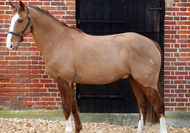As the weather grows colder, nature compensates by ensuring your horse's coat grows thicker. A thick winter coat is fine for horses and ponies who are going to stay turned out and unrugged during the cold months - especially if they are native breeds - but if your horse is going to continue to work and exercise his natural heavy coat could lead to problems.
At the onset of winter it is therefore advisable to give your horse a haircut. Clipping all over is generally not necessary (unless your horse is a busy all-year top competitor that is stabled most of the time), but a carefully planned clip styled to suit his needs has several benefits:
Horses sweat during exercise. Hard workers sweat more, but even light exercise can bring on a heavy sweat under a thick winter coat. Sweat trapped in a heavy, shaggy coat is not only uncomfortable for the horse, but can take a long time to dry in cold weather, leaving him chilled and his metabolism working overtime to stabilise his core body temperature. This leaves him at risk of catching a chill and losing condition.
Thick, sweaty coats are also more difficult to groom, so clipping makes your life easier too!
Of course, if you do clip your horse for winter, you will have to compensate for his lack of natural insulation by rugging him up appropriately, and providing suitable shelter to protect him from the elements.
If you clip your horse for winter do so in early autumn. You may need to repeat the process two or three times as winter advances, to keep regrowth at bay. Stop clipping him in early spring, though, because that is when the new summer coat will start to appear.
Types of Horse Clips
A light clip involves just the underside of the neck up to the centre of the belly (the bib area), which will leave your horse well covered enough to be turned out without a rug unless the weather is particularly freezing and inclement.
A low trace clip means removing the hair under the neck and belly right back to the loins, while a high trace clip extends further up the horse's flank, and up to the cheeks. Leaving the hair on the head, legs and the top of the body and neck provides warmth during turn out, but allows for exercise without overheating.
A blanket clip means removing hair from all areas, except for the legs and the area that would be covered by an exercise blanket. This suits a horse that has regular exercise through the winter and is turned out during the day.
A hunter clip is best for horses in heavy winter work. Remove all the hair except for an area in the shape of the saddle, and on the legs.
A full clip, as has been said earlier, is not usually applied except for horses that compete through the winter. Special care needs to be taken to ensure fully clipped horses are kept warm and comfortable.

If you can't decide how much to clip, err on the side of caution and start off small! After all, you can always clip further if it seems necessary, but you can't put back hair that's already been removed.
If you have never clipped a horse before it is wise to seek advice from a seasoned clipper before investing in a set of clippers. It's probably best to watch an expert at work before trying it yourself.
If possible bath your horse the night before you plan to clip him, and then groom him well. If the coat is dirty it could clog up and blunt the clipper blades.
Mark out the area you plan to clip using chalk.
If you're a novice beware of frightening the horse, so remain calm and turn the clippers on well away from him before approaching him slowly, allowing him to see the source of the noise. Make sure the clippers are in good condition, well-oiled and the blades are not worn. Use long strokes and clip against the direction of the hair growth, pulling the skin taut with your free hand.
You can build up your confidence by watching some of the many tutorials and videos about horse clipping online.
Good luck with your clipping ...
Get all your Clippers, Oils and Accessories



